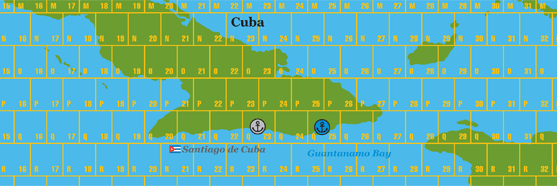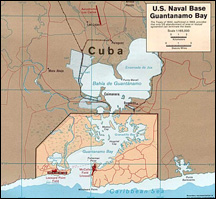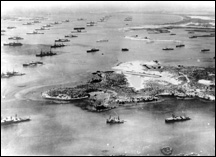| Guantánamo
Bay
By Mike Bennighof, Ph.D.
September 2017
Though the United States gained a powerful
position in the Caribbean basin following
the Spanish-American war of 1898, it was not
until that war’s aftermath that American
leaders looked closely at projecting power
in the region. In 1900, influential naval
thinker Alfred Thayer Mahan published The
Problem of Asia, a book that tremendously
impressed at least one of his readers, Vice
President Theodore Roosevelt.
Mahan pointed to China as an enormous potential
market for American products, following the
“Open Door” policy inaugurated
in 1899. He noted that a canal across Central
America would give American merchants enormous
advantages over their European rivals. The
canal, in turn, would have to be protected
by bases in and around the Caribbean Sea.
European nations would have to be kept out
of the region, Mahan preached, lest they threaten
the canal and in turn this valuable potential
trade between the American East Coast and
China. Thanks to the distances involved, the
U.S. Navy did not need overall numerical superiority
to muster a regional advantage against European
interlopers.

Roosevelt ascended to the presidency in
1901, following the assassination of William
McKinley by an anarchist. He quickly set to
work to carry out Mahan’s vision. The
United States negotiated an agreement with
Colombia, which then ruled Panama, for a canal
across the isthmus there. The Colombian representative
agreed on a price, but the Colombian Senate rejected
the treaty, desiring more money. Not being
one to give up so easily, Roosevelt ordered
that a revolution be engineered in Panama.
No land communications existed between Panama
and Colobia proper, and with the U.S. Navy
preventing reinforcements from landing in
Panama the revolutionaries were soon successful
— with the help of U.S. Marines. The
revolutionaries immediately accepted the deal
Colombia had spurned.
With a canal assured, the waterway would
need protection. Mahan had recommended Jamaica
as the ideal central location for a naval
base to control the Caribbean, but acknowledged
that the island’s British rulers might
not be willing to part with it. As an alternative
he suggested the southeastern coast of Cuba,
somewhere near the port of Santiago de Cuba.
Santiago de Cuba lies at the head of a long
and narrow channel, and in 1898 a Spanish
squadron had been easily annihilated by the
Americans waiting outside, as each Spanish
ship had to make the passage individually
and be met by the combined fire of the American
fleet. Nearby, Guantánamo Bay presented
a much better site. American troops had landed
there during the campaign to capture Santiago
de Cuba, and American’s first casualties
of the war had taken place there when two
Marines were killed.

CIA map of the Guantánamo Bay
Naval Station.
|
The Cuban government proved a much more pliable
negotiating partner than the Colombians. McKinley
had overseen the insertion of the Platt Amendment
into the Cuban constitution in 1901, making
its acceptance a condition of Cuban independence
and the withdrawal of American troops. This
clause gave the United States the right to
set Cuba’s relations with foriegn governments,
including that of the United States. The Cubans
had no choice but to sign the lease Roosevelt
presented them: The United States would hold
the 45-square-mile property in perpetuity,
for the rental fee of 2,000 gold coins per
year. The agreement handed the land to the
Americans to “do any and all things
necessary to fit the premises for use as coaling
or naval stations only, and for no other purpose.”
The Platt Amendment was finally repealed
in 1934, and a new lease was negotiated to
adjust the payment for inflation. Otherwise
it followed the prior agreement, including
the “no other purpose” clause,
and clarified that the lease could not be
broken without the agreement of both governments.
Following the Cuban Revolution of 1959, the
base’s existence became a sore point
of U.S.-Cuban relations, with Fidel Castro’s
government making repeated demands for its
return. Castro cut off land communications
in 1964, and the base currently supplies its
own water and power, with much of the latter
coming from a new set of high-tech wind turbines.
The United States continues to pay its rent,
but the Castro government has not cashed any
of the checks since 1959. The Castro government
claims to reject the lease terms, but American
lawyers point to Castro’s having cashed
the first rent check as signalling acceptance.
Interpreting the “naval base”
clause very broadly, in 1991 the U.S. began
making use of the territory for purposes the
lease clearly never intended, housing 34,000
Haitian refugees there. More recently, the
base has become internationally known as a
site where prisoners from the U.S. “War
on Terror” are held. Legal skirmishing
continues as to the status of these prisoners
and the legality of their imprisonment; the
United Nations and the European Union have
both requested that the prison be closed. Years after Barack Obama promised to close the facility, it remains in operation.

The combined Atlantic and Pacific fleets
exercise at Guantánamo Bay, 1910.
|
For its first decades, the base at Guantánamo
served its stated purpose, serving as a coaling
station located conveniently between the Panama
Canal and the Navy’s East Coast bases.
It did not have repair facilities, relying
on mobile repair ships while the fleet was
on station there, but did have a large and
well-sheltered anchorage and soon acquired
a large hospital. Soon the Atlantic Fleet
was deploying to the site every January for
winter maneuvers. The ships exercised in the
waters of the Windward Passage and sometimes
deeper into the Caribbean.
In January 1913 the maneuvers for the first
time included aircraft, as the entire Navy
aviation establishment joined the fleet for
eight weeks at Guantánamo Bay, setting
up the “Aviation Camp” that eventually
grew into McCalla Field, now closed. Winter
maneuvers continued at Guantánamo Bay
every year until World War II.
In U.S.
Navy Plan Gold, Guantánamo
Bay is the strategic Amercain base foreseen
by Roosevelt and Mahan. Ships based there
can easily intercept French fleets trying
to proceed from their bases at Martinique
and Guadeloupe toward the Panama Canal, and
it’s a very useful refueling stop for
ship hunting French raiders in the Caribbean
basin. It commands the Windward Passage between
Cuba and Hispaniola, and fleets can easily
operate from there either north or south of
the barrier presented by the islands of the
Greater Antilles. And given its location on
a foreign island and lack of permanent facilities,
it’s not a particularly tempting target
for French attack; the American public will
be far less sensitive to bombardments of Guantánamo
Bay than of Miami. They just don't care what happens there. Mahan knew his Americans.
Click
here to order Great War at Sea: Plan Gold.
Mike Bennighof is president of Avalanche Press and holds a doctorate in history from Emory University. A Fulbright Scholar and award-winning journalist, he has published over 100 books, games and articles on historical subjects.
He lives in Birmingham, Alabama with his wife, three children and his dog, Leopold.
|
